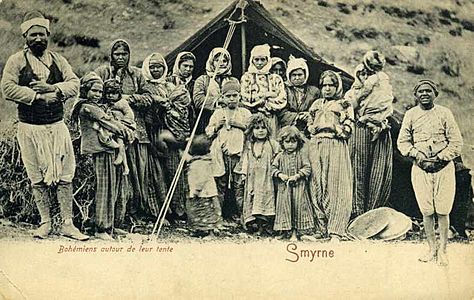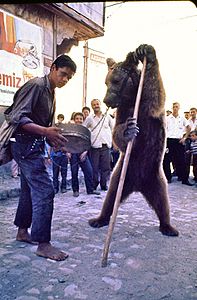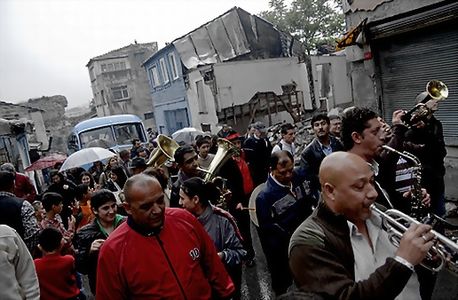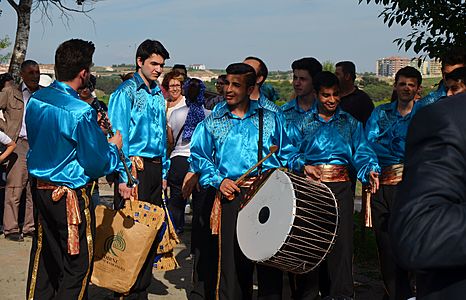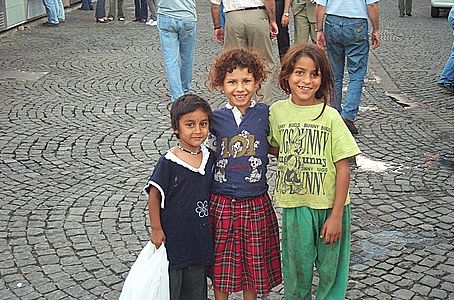Romani people in Turkey facts for kids
| Romanlar | |
|---|---|
| Total population | |
| around 5,000,000 | |
| Regions with significant populations | |
| Istanbul, East Thrace, Marmara Region, Aegean Region, İzmir Province | |
| Languages | |
| Turkish as first language, in lesser case Rumelian Turkish, nearly extinct Sepečides Romani and Rumelian Romani | |
| Religion | |
| Sunni Islam, Sufism of Qadiriyya - Tariqa | |
| Related ethnic groups | |
| Lom people, Dom people, Abdal of Turkey |
The Romani people in Turkey (Turkish: Türkiye'deki Romanlar) are Turkish citizens. They are the largest group of Turkish Roma. Most are Sunni Muslims and follow a spiritual path called Sufism. They speak Turkish as their main language, often with their own special accent. They have also adopted many parts of Turkish culture.
Over time, many Romani people in Turkey have chosen to identify as Turks. This helped them to be more accepted by others. Some even say they are part of ancient Turkish groups like the Oghuz Turks.
Since 1996, their official name in Turkey is Romanlar. They are also known by other names like Manuş (meaning "Human") or Çingene (meaning "Gypsy"). In the past, during the Ottoman Empire, they were called Cingân, Kıptî, or Mısırlı. It is thought that about 5 million Romani people live in Turkey today.
Contents
A Look at Romani History
Romani people have lived in the area now known as Turkey for a very long time. Records show they were in Thrace as early as AD 800. Around 1054, a group called Athinganoi settled outside the walls of Constantinople (now Istanbul). Later, this area became known as Sulukule, which is believed to be the oldest Romani settlement in Europe.
As the Ottoman Empire grew, Turkish-speaking Muslim Romani people moved into Rumelia (southeastern Europe). A famous Ottoman historian, Evliya Çelebi, wrote that in 1453, Mehmed the Conqueror brought Muslim Romani people to Istanbul. He also mentioned that Muslim Romani people were given their own special area to govern in Kırklareli Province in 1530. This was ordered by Suleiman the Magnificent. Even today, Romani people in Turkey often see Thrace as their homeland.
Where Did They Come From?
The Romani people in Turkey have a mixed background. Many of their own stories say their ancestors came from Hindustan (India). Language experts agree that the Romani language has its roots in Central India. It shares many words and grammar rules with Indian languages. In 2016, India's Minister of External Affairs even called the Romani community "children of India."
How Genes Tell a Story
Studies of genes also suggest that early Romani people came from the Indian subcontinent. For example, one study shows that Turkish Romani people are related to the Changar tribe from Pakistan. Over time, the genes of Ottoman Turks, Greeks, and South Slavs also mixed with those of Romani people in the Balkans.
Moving to Turkey
Many Romani groups moved to Turkey at different times:
- In 1923, during a population exchange between Greece and Turkey, Muslim Romani groups like the Sepetčides (Basketmakers) moved to Turkey.
- Between 1878 and 1989, Turkish-speaking Muslim Romani people moved from Bulgaria to Turkey.
- In the early 1950s, Muslim Romani people from Bulgaria settled near Çanakkale.
- From 1953 to 1968, Muslim Romani and Turks from Yugoslavia also moved to Turkey.
Where Romani People Live in Turkey
Most Romani people in Turkey live in East Thrace, the Marmara Region, and the Aegean Region. Cities like Edirne and Istanbul have many Romani residents.
Romani Culture and Traditions
The Romani people in Turkey speak Turkish as their first language and have fully adopted Turkish culture. They are Cultural Muslims, following the Sunni Islam faith. They celebrate important life events like engagements and weddings with big parties.
Romani music is very famous in Turkey, especially their bands with a special 9/8 beat. Many Romani people are proud to identify as Turks and feel they share the same culture as other Turks. Belly dance is also a popular art form, performed by both women and men. In Edirne, they celebrate the Kakava festival every year.
Some Romani groups have their own unique ways. For example, the Kağıtçılar (Papermakers) in Istanbul have a dialect that other Romani groups in their area don't understand. Turkish-speaking Romani people in Turkey often see other Romani groups, especially Christian Romani, as "foreigners."
Legal Status in Turkey
In modern Turkey, Muslim Romani people are not officially recognized as a separate ethnic minority. This is because they are Muslim, and in Turkey, all Muslims are generally seen as part of the main population. This idea goes back to the Treaty of Lausanne in 1923, which mainly focused on protecting non-Muslim minorities.
Sufism and Romani People
Many Romani people in Turkey are part of a Sufi group called the Hindiler Tekkesi. This group follows the Qadiriyya path and was started in 1738 by an Indian Muslim leader.
Romani Groups in Turkey
Romani people in Turkey are often divided into two main groups: the Sedentary Yerli and the Semi-Nomadic Çerge. These groups are often named after the jobs their ancestors used to do, like basket making, flower selling, or blacksmithing. Today, many Romani people work in various jobs, often struggling financially.
The Yerli and Çerge live near each other but sometimes have differences. The Yerli usually speak only Turkish, while the Çerge speak both Turkish and Rumelian Romani. Even though both groups are Muslim, the Yerli sometimes look down on the Çerge. The Yerli believe the Çerge originally came from the Balkans.
The Sepetçi Subgroup
Since the time of the Ottoman Empire, Muslim Romani basket weavers and musicians were highly respected. The best basket makers in Istanbul came from Sulukule. Today, in East Thrace, the Sepetçi Romanlar (Basket-weaver Roma) still continue their traditional craft. There are even associations and cooperatives to support them. Some descendants of Sepetçides who moved from Greece in 1923 still live in İzmir.
The Ayjides Subgroup
The Ayjides or Ayıcı were once Bear-leaders. They used to train and perform with Tame bears until the 1990s.
Connecting with Romani Heritage
Through events like the World Romani Congress, Romani people in Turkey have become more interested in their own heritage and language. While the Rumelian Romani dialect is still used by some in East Thrace, and Sepečides Romani is nearly gone in Izmir, there's a growing desire to keep their culture alive.
Gallery
-
A dancing bear and its owner in Samsun around 1970.
-
Romani people in Istanbul in 2008.
-
The Kakava celebration in Edirne in 2015.
Famous Turkish People of Romani Background
- Sibel Can, a popular folk and classical music singer.
- Didem, a well-known belly dancer, model, and singer.
- Kibariye, an Arabesque-pop singer.
- Özcan Purçu, a politician.
- Hüsnü Şenlendirici, a talented musician.
- Selim Sesler, a master clarinet player.
- Ankaralı Turgut, a musician.
- Rafet el Roman, a pop star.
See Also
- Minorities in Turkey
- Abdal of Turkey
- Muslim Roma
- Turkish Roma


